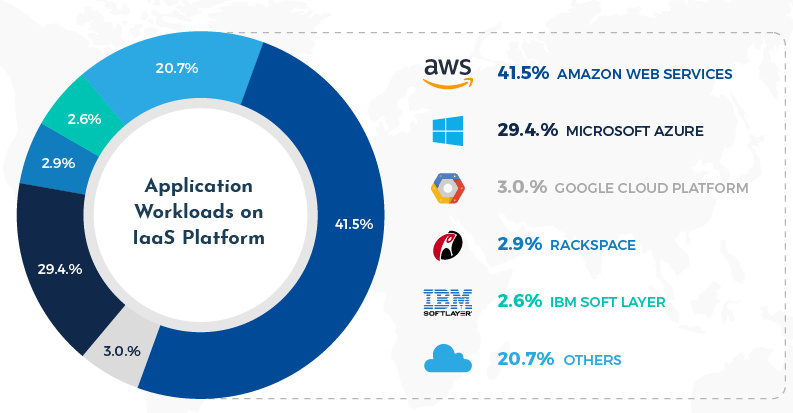Technology
The Impressive Stats Behind Amazon’s Dominance of the Cloud
To the average person, cloud computing must seem quite magical.
All at once, the cloud provides instant access to all of your data, photos, music, and applications, without you having to store any of that data locally. In fact, users can access the cloud from practically anywhere in the world, and across multiple devices and platforms.
Yet, this all happens without you actually seeing any visible infrastructure. With data now being created at record speeds, where the heck is all this information being physically stored?
The Rise of AWS
Even though you can’t see the vast infrastructure that runs the cloud, it does exist somewhere.
As today’s infographic from RapidValue shows, much of this infrastructure is owned and operated by Amazon, through its extremely profitable subsidiary of Amazon Web Services (AWS).
Here are the key stats on this dominant service that powers much of the internet today:

Amazon Web Services (AWS) quietly launched in 2002, and in a short time has been able to scale into the largest single player in cloud computing (IaaS, PaaS).
While it is a well-known name to software developers, AWS emerged on a more mainstream basis once its financials were separated from those of parent Amazon.com.
Even in 2018, AWS delivered most of Amazon’s operating income.
AWS By the Numbers
To understand the true scale of AWS, you need to look at the numbers.
- AWS has over 1 million active users in 190 countries
- AWS has 5x more deployed cloud infrastructure as their next 14 competitors combined
- Each day, AWS adds as much infrastructure as they used to run in total 7 years back
- Amazon S3 is designed to deliver 99.999999999% durability and scale past trillions of objects worldwide
- AWS partner, Netflix, accounts for up to one-third of Internet traffic during peak usage times
- AWS accounts for 41.5% of the public cloud market, bigger than Microsoft, Google, Rackspace, and IBM combined
Through incredible economies of scale, AWS has decreased its prices at least as many as 60 times since its launch – and despite this, AWS generated a whopping $26 billion in revenue for parent Amazon in 2018.
Brands
How Tech Logos Have Evolved Over Time
From complete overhauls to more subtle tweaks, these tech logos have had quite a journey. Featuring: Google, Apple, and more.

How Tech Logos Have Evolved Over Time
This was originally posted on our Voronoi app. Download the app for free on iOS or Android and discover incredible data-driven charts from a variety of trusted sources.
One would be hard-pressed to find a company that has never changed its logo. Granted, some brands—like Rolex, IBM, and Coca-Cola—tend to just have more minimalistic updates. But other companies undergo an entire identity change, thus necessitating a full overhaul.
In this graphic, we visualized the evolution of prominent tech companies’ logos over time. All of these brands ranked highly in a Q1 2024 YouGov study of America’s most famous tech brands. The logo changes are sourced from 1000logos.net.
How Many Times Has Google Changed Its Logo?
Google and Facebook share a 98% fame rating according to YouGov. But while Facebook’s rise was captured in The Social Network (2010), Google’s history tends to be a little less lionized in popular culture.
For example, Google was initially called “Backrub” because it analyzed “back links” to understand how important a website was. Since its founding, Google has undergone eight logo changes, finally settling on its current one in 2015.
| Company | Number of Logo Changes |
|---|---|
| 8 | |
| HP | 8 |
| Amazon | 6 |
| Microsoft | 6 |
| Samsung | 6 |
| Apple | 5* |
Note: *Includes color changes. Source: 1000Logos.net
Another fun origin story is Microsoft, which started off as Traf-O-Data, a traffic counter reading company that generated reports for traffic engineers. By 1975, the company was renamed. But it wasn’t until 2012 that Microsoft put the iconic Windows logo—still the most popular desktop operating system—alongside its name.
And then there’s Samsung, which started as a grocery trading store in 1938. Its pivot to electronics started in the 1970s with black and white television sets. For 55 years, the company kept some form of stars from its first logo, until 1993, when the iconic encircled blue Samsung logo debuted.
Finally, Apple’s first logo in 1976 featured Isaac Newton reading under a tree—moments before an apple fell on his head. Two years later, the iconic bitten apple logo would be designed at Steve Jobs’ behest, and it would take another two decades for it to go monochrome.
-

 Green1 week ago
Green1 week agoRanked: The Countries With the Most Air Pollution in 2023
-

 AI2 weeks ago
AI2 weeks agoThe Stock Performance of U.S. Chipmakers So Far in 2024
-

 Markets2 weeks ago
Markets2 weeks agoCharted: Big Four Market Share by S&P 500 Audits
-

 Real Estate2 weeks ago
Real Estate2 weeks agoRanked: The Most Valuable Housing Markets in America
-

 Money2 weeks ago
Money2 weeks agoWhich States Have the Highest Minimum Wage in America?
-

 AI2 weeks ago
AI2 weeks agoRanked: Semiconductor Companies by Industry Revenue Share
-

 Travel2 weeks ago
Travel2 weeks agoRanked: The World’s Top Flight Routes, by Revenue
-

 Countries2 weeks ago
Countries2 weeks agoPopulation Projections: The World’s 6 Largest Countries in 2075















